A Physical Therapist Is Sharing Very Doable Tips And Tricks For Dealing With Back Pain And Posture While Working Remotely
As many of us continue to work from home, it's easy to be hard on ourselves for slouching, or fixate on finding the "perfect posture" to sit or stand in all day.
Tuna Dunn / Via giphy.com
But here's the thing: There's no such thing as perfect posture. That's according to physical therapist Dr. Craig Lindell, of the [P]Rehab Guys, a Los Angeles–based group dedicated to educating people on things like preventative physical rehab and the truth behind "bad" posture. I reached out to Dr. Craig to learn more about both — and get some tips and practical stretches to relieve my own lower back pain while working from home. (It sucks getting older.)
![The teammates of [P]Rehab known as "the [P]Rehab Guys" pose in front of a mural](https://s.yimg.com/ny/api/res/1.2/Aeyz7E1VjKDo27ZlTOau0A--/YXBwaWQ9aGlnaGxhbmRlcjt3PTk2MDtoPTExMDU-/https://media.zenfs.com/en/buzzfeed_articles_778/22fdbd2df8c96fa1b1425ffc17b945e2)
For context, my butt is in a chair for most of the day, and my back constantly feels like it got kicked by the famous horse Seabiscuit.
"Everything that has been ingrained into you about the word posture may not be true," Dr. Craig told BuzzFeed. "As humans, we're not meant to be in the same position all day. We're meant to move. So I tell my patients that your 'best' posture is your next posture."
I still wanted to know though: Is there such a thing as a bad posture or a posture that even leaves us more prone to pain? The short answer, according to Dr. Craig: Unless you have a preexisting injury, no.
"More people are spending time at home and working remotely," he explained. "You could spend one day hunched forward, looking down, and may feel fine. But if you're dealing with more stress, had a recent injury, or recently tweaked something because you were carrying something too heavy, then the next day, those positions may not feel good. There's nothing inherently wrong with that position. It's just a matter of now, your equilibrium is thrown off."
FOX / Via giphy.com
Instead of trying to find a "better" posture and staying in it for eight hours straight, Dr. Craig and his team actually prefer that a person moves from one position to another position — even if you think those positions are "bad" — because it's more important to avoid being sedentary.

"There's a study that actually looked at military recruits who naturally are given instructions like 'stand straight, shoulders back, chest up' while they're marching, and they have to maintain this ideal posture," Dr. Craig said. "And it was reported that individuals who focused on maintaining a certain position for an extended period of time actually reported more pain and more discomfort than individuals who were getting into any position that felt comfortable."
Our bodies prefer to constantly be in motion and that's why Dr. Craig's team recommends a standing desk. Not because sitting is better than standing, but rather because we're more likely to shift positions when we're standing.
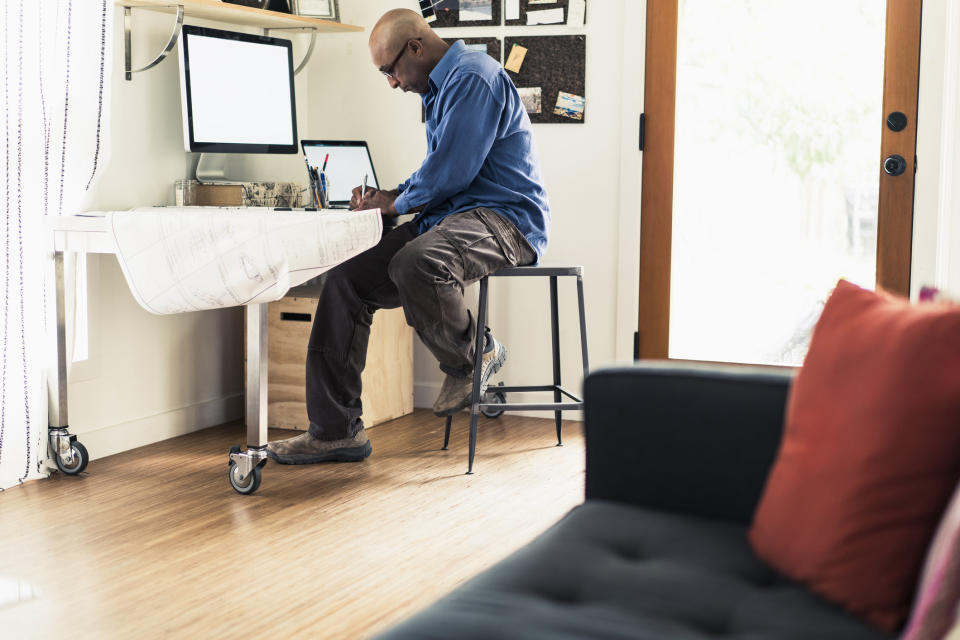
So instead of trying to find the perfect ergonomic work-from-home setup, the [P]Rehab Guys find it more beneficial to keep your body moving, or even do some stretches for one minute at the top of every hour.
Another tip: Add a stool if possible to your setup so that you could occasionally put your leg up and increase your arsenal of positions to switch into. You could even replace your regular chair with one.
Even after hearing this, my skepticism persisted. If I'm switching up positions at my standing desk like my name is Ariana Grande, then why do I still feel pain being activated? "Pain is your nervous system talking to your body," Dr. Craig told me. "It's a part of life. So if you're experiencing pain, that means you're alive."
I actually got choked up when he told me that. Because if I'm being honest, I previously felt so resigned to my pain. I just relented that I was always going be cursed with it because of my constant slouching and hunching at the computer. It was refreshing to hear that my pain is not something I should feel bad about.
"It may not be all that realistic to expect no pain for the rest of your life," Dr. Craig said. "And how we feel about our posture changes with how we look at it when we are in pain versus when we aren’t. That’s why pain isn’t indicative of good or bad posture. Because posture is always dynamic. Even in a more 'perfect' posture, your body's going to want to move."
However, if there is a certain position that tends to activate your pain, Dr. Craig said you should focus on counteracting it.
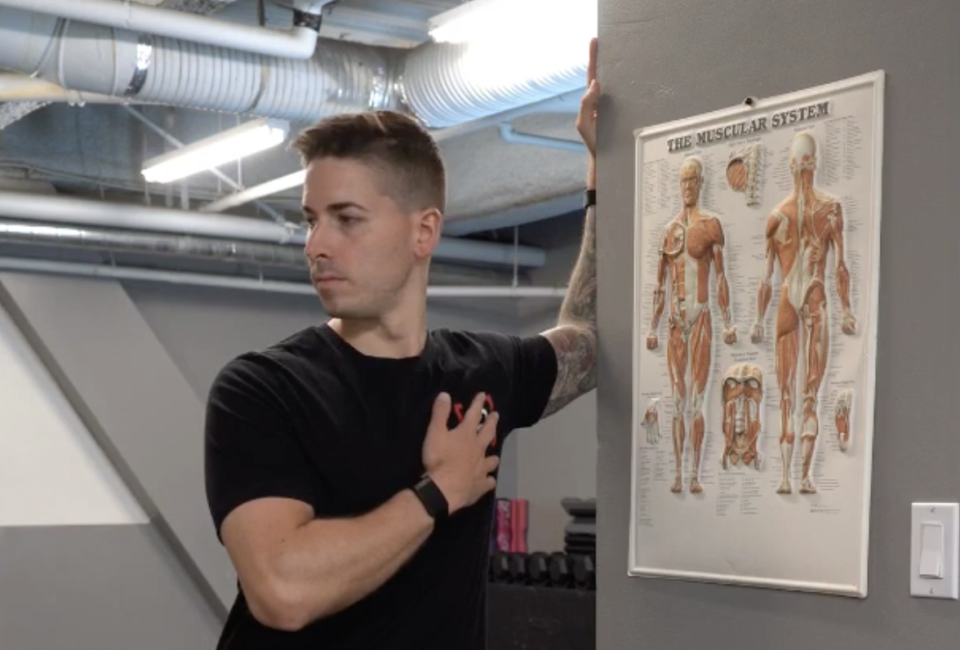
"During the day, we all like to snack. So just as much as your brain and body are craving something to eat, think of your muscles, bones, and joints craving a 'movement snack.'
"When you start dealing with pain, pay attention to it. That's your body talking to your brain saying, 'I want a movement snack.' So give it a movement snack and do 5–10 reps of any movement that feels good. That's counteracting the position you've been in."
Dr. Craig then demonstrated two moves — or "movement snacks" — anyone could do right at their desk. The first one: a sunrise salute. Do this one either seated or standing up.
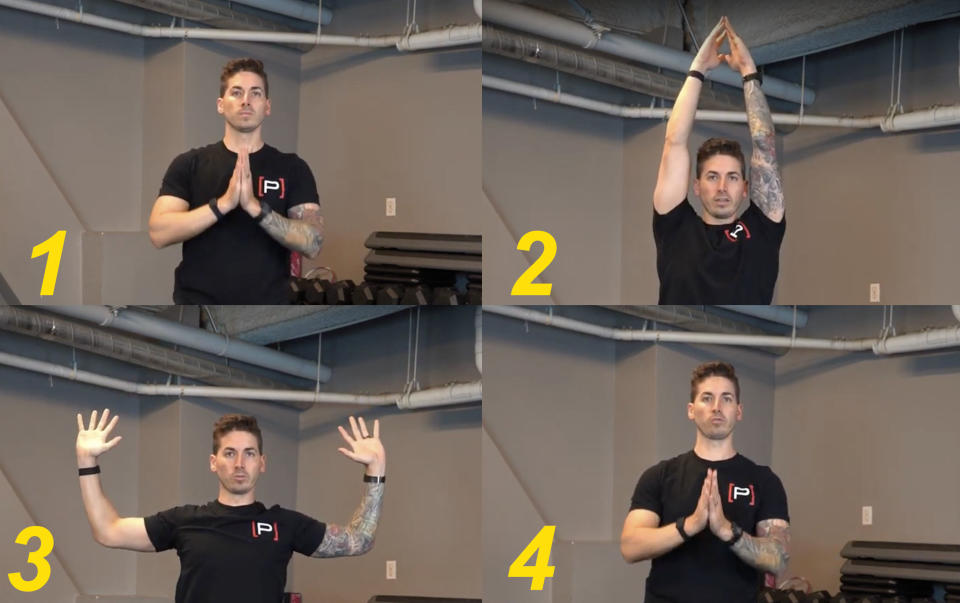
“[Pretend] there's a balloon attached to your head that's pulling your head and neck toward the ceiling,” Dr. Craig advised. “Get as long as possible. Then get your chest upright as far as possible, bring your hands together, reach as far as you can overhead, take a deep breath in, and then just breathe out all the BS and all the tension."
The second move was a hip flexor stretch, shown below. For me, this one immediately provided relief in balancing out the slouch of my lower back that I usually settle into when sitting down.
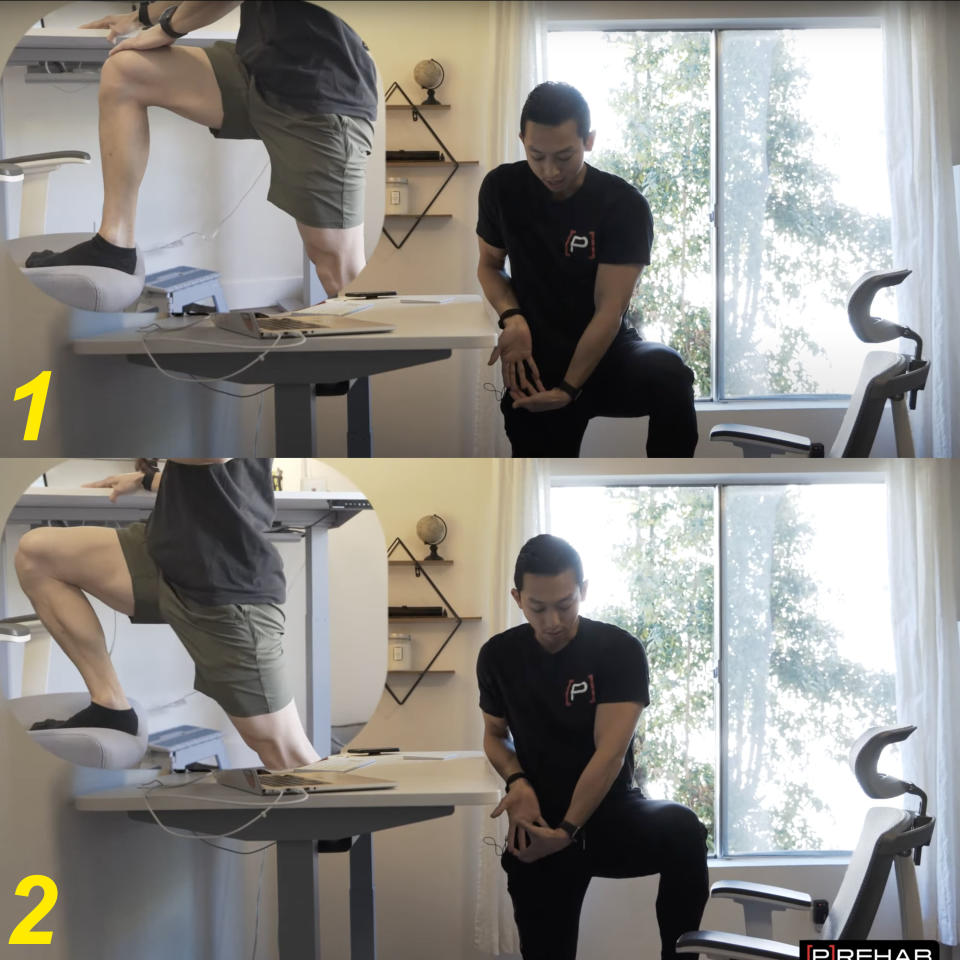
For this one, you can do it right on your chair or on a stool if you have one nearby.
"Get a foot up, reach overhead, and shift your hips forward," Dr. Craig explained. "With that head and neck cue, pull your chin in as well so that you kind of feel a stretch at the base of your skull."
I also found a third stretch I really liked that I could do in my chair: a seated cat camel. (For more quick stretches and exercises, check out their extensive YouTube library.)
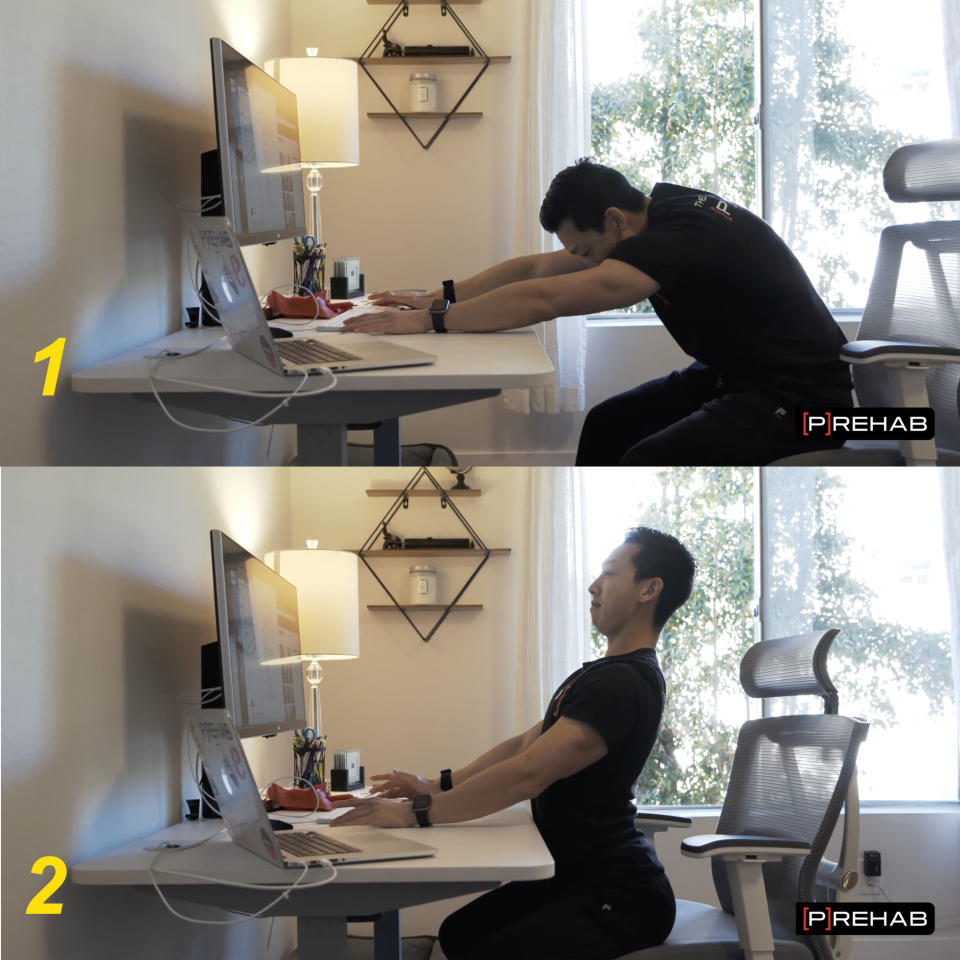
Do 5 to 10 of any of these stretches — all while taking deep breaths in — and you should feel some relief.
To recap, Dr. Craig said, "While you're working, stand for as long as you can. And when your body starts saying, 'Hey, something doesn't feel comfortable,' sit down for as long as you can."
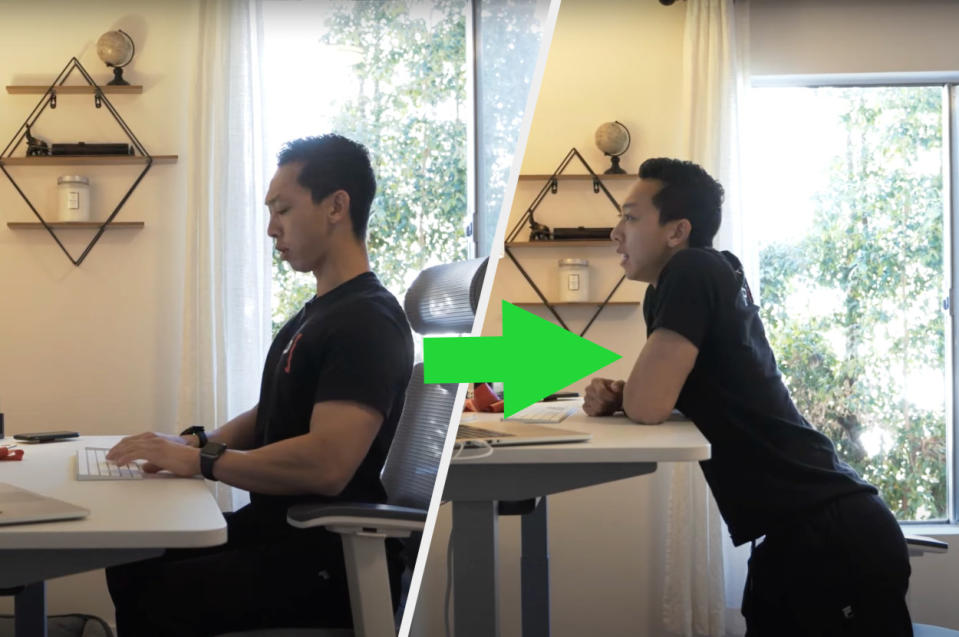
"And then when sitting doesn't feel good, can you get set up into a half-kneel on your chair? Can you go back to standing? Can you sit on a stool versus a chair? Can you lie on your back? Can you lie on your stomach? Or maybe your body is giving you the signal that it's time to get out of your house and just go for a 15- minute walk to relieve your entire body."
And if pain is your body's signal that it's experiencing an overload of stress in a particular area, it's no surprise that people are experiencing a lot more discomfort during this pandemic. "I once heard from a neurosurgeon, 'During very stressful times, stress can manifest itself physically.' And that's really relevant right now with COVID."
KC Green / Via giphy.com
"During the past few years, we're working from home, schools are shutting down, or there's issues with your job, whatever it may be," he said. "And maybe now, you're experiencing more headaches, neck pain, or tension than ever. During the most stressful times of my life, all of my orthopedic issues started popping up and my lower back pain was getting worse."
That's why Dr. Craig recommends his own patients keep track of when pain occurs in their bodies and what triggers it.

"Is it when you talk to your boss or when there are some things happening with your kids? Or is it when there are things happening in the world? Is it when you're scrolling through social media? From there, you can learn to not react to the pain, but respond."
When he puts it that way, it seems a lot more enjoyable to go for a walk or do a light stretch when pain starts to creep in, rather than enter a state of despair.
Once we're aware of what triggers pain in our bodies, we're able to be proactive in how we address it so that we experience less of it.
![Neon sign of [P]Rehab against an exposed brick interior](https://s.yimg.com/ny/api/res/1.2/JBNDoYqCaYmcYk9tDVcGUQ--/YXBwaWQ9aGlnaGxhbmRlcjt3PTk2MDtoPTY0MA--/https://media.zenfs.com/en/buzzfeed_articles_778/102e202a10de697c20b0fe838342c738)
"In the same way that you brush your teeth or take your car to a mechanic for upkeep," Dr. Craig said, "there's certain things that you check in on regularly. And you should be doing the same thing for your body. Don't wait until something is a problem."

